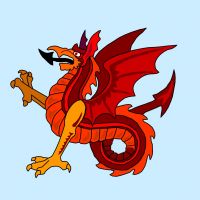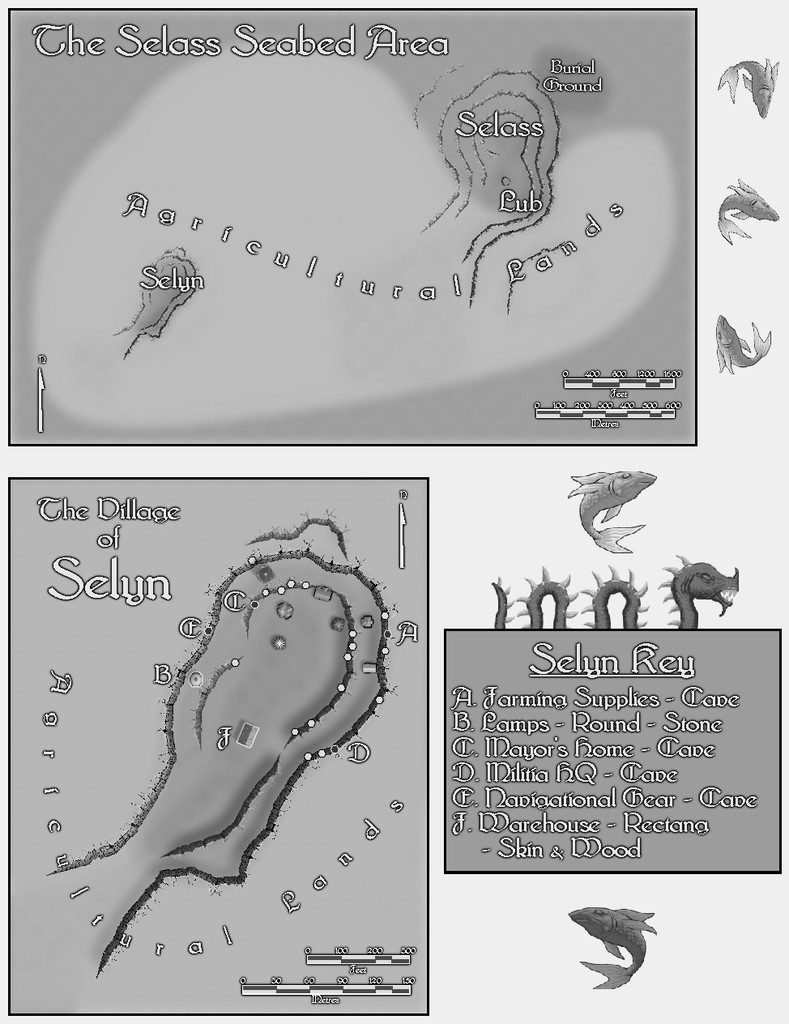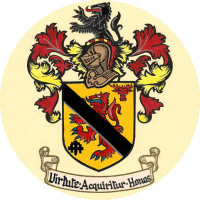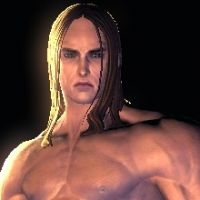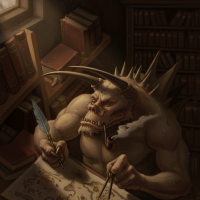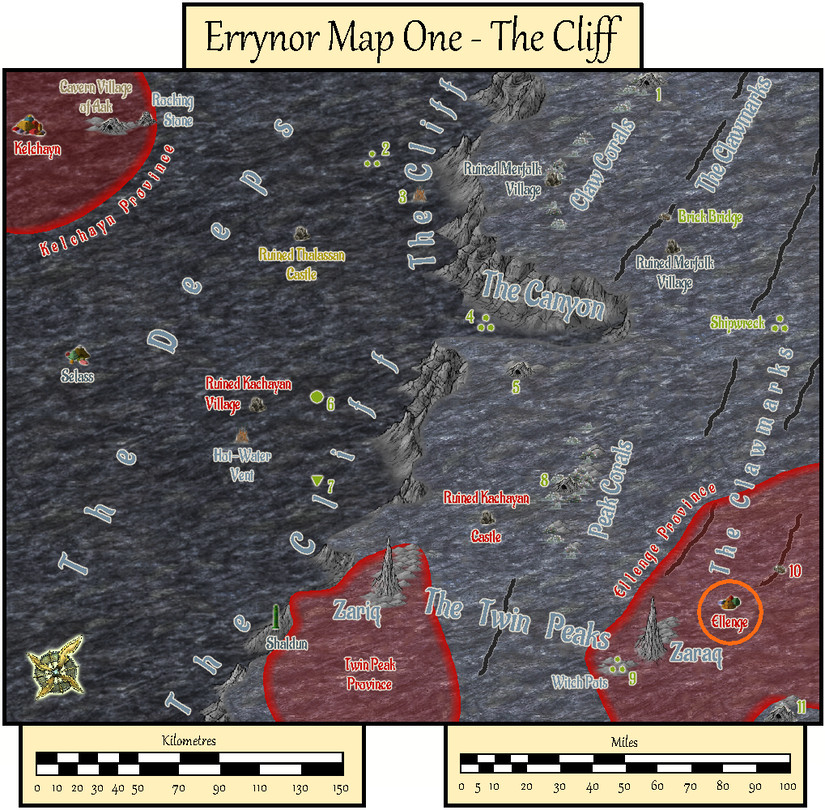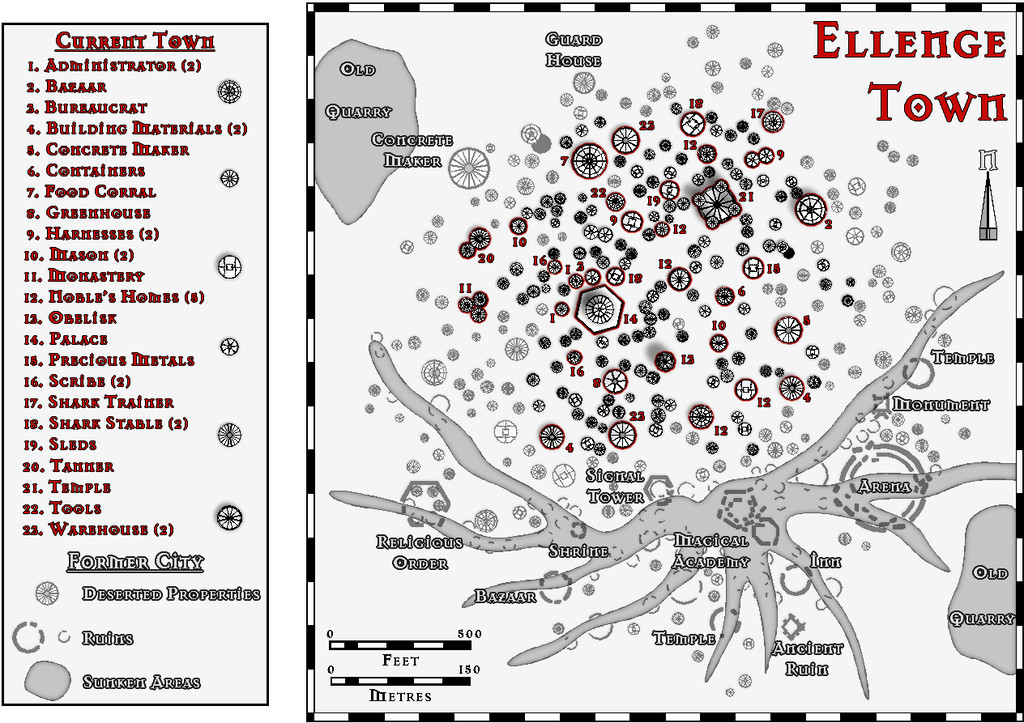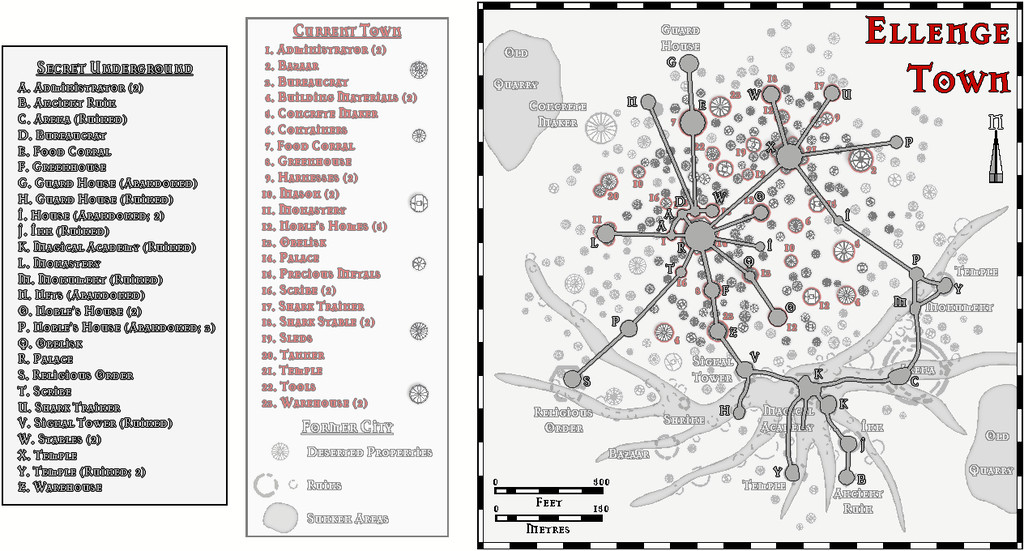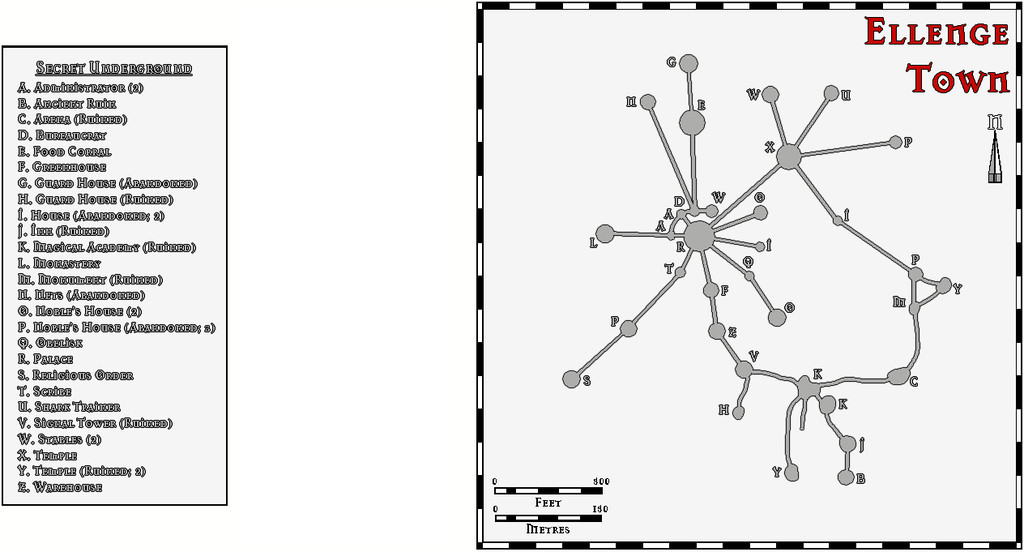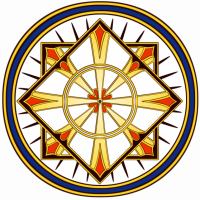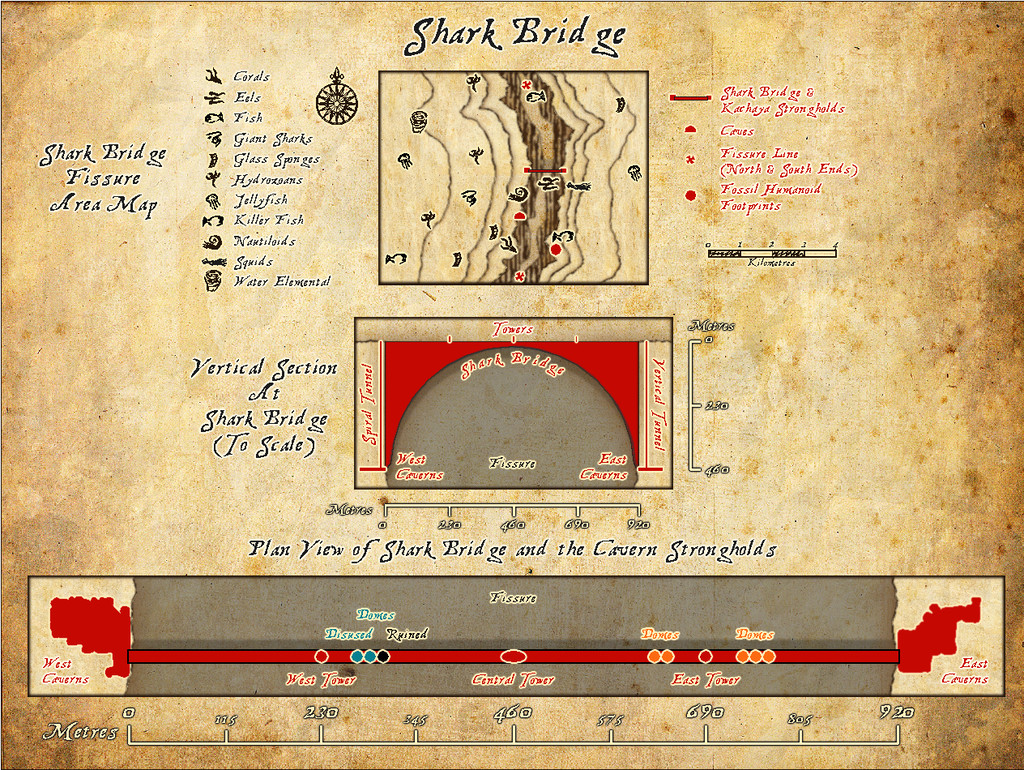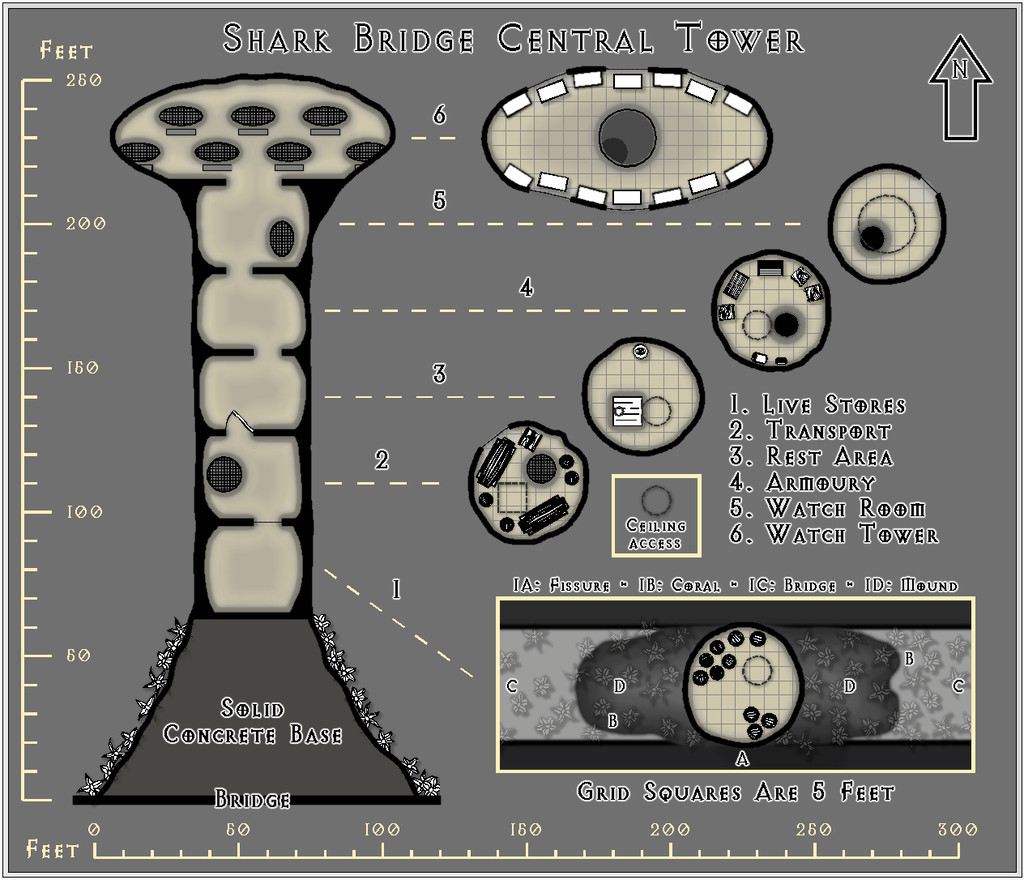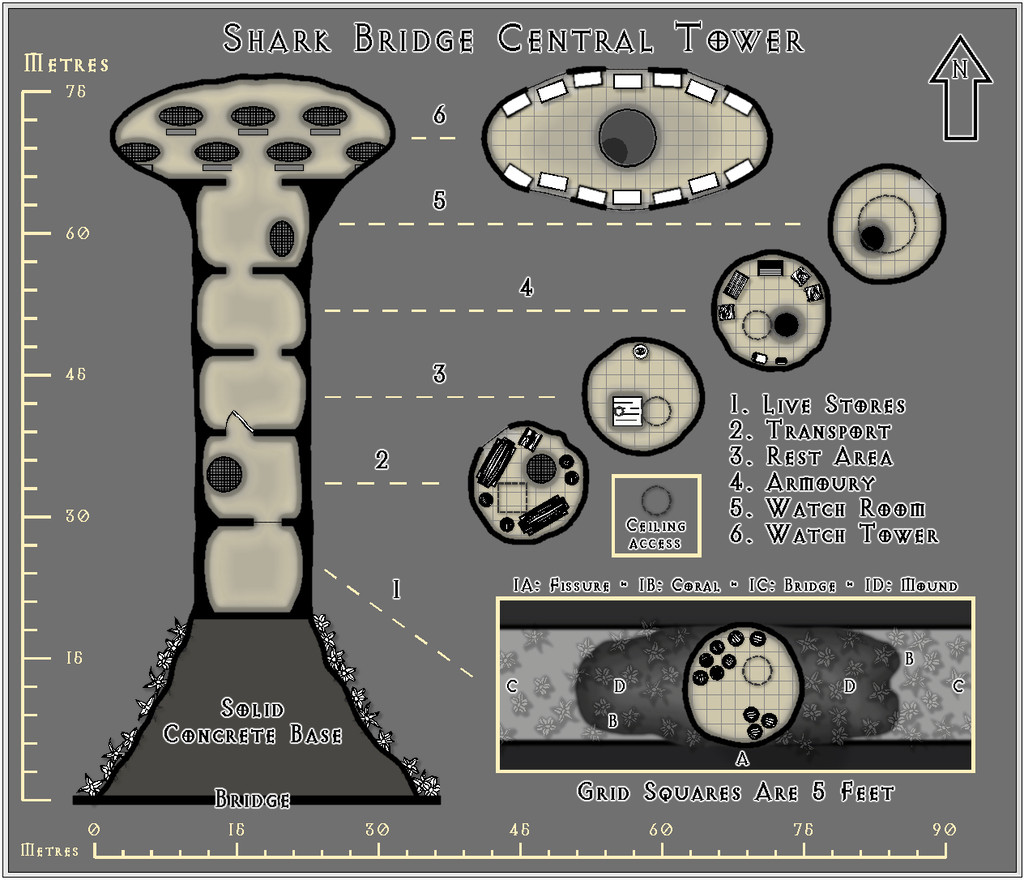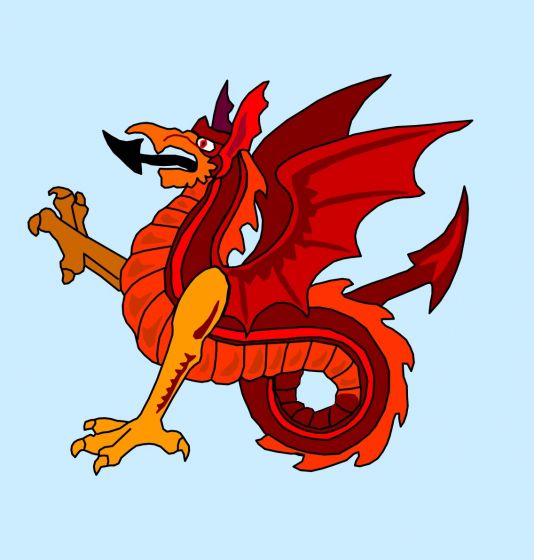
Wyvern
Wyvern
About
- Username
- Wyvern
- Joined
- Visits
- 3,127
- Last Active
- Roles
- Member
- Points
- 5,360
- Rank
- Cartographer
- Badges
- 24
-
Community Atlas: Errynor - Selass Town
While working on the Ellenge Town map for the Kachaya, I'd also prepared some random tables for designating shops and facilities suitable for Merfolk settlements, given that all undersea civilisations will have a degree of similar requirements for places to live. As I wanted to provide some ideas to the Community Atlas more generally too on developing undersea settlements for all the main races I'd situated in Errynor's oceans, from what had been decided for the Map 01 area, the logical next map was a Merfolk settlement. Of the two still-inhabited ones on Map 01, the Shaldun castle stronghold set in the line of The Cliff itself seemed too similar a location to what I'd already explored for the Shark Bridge area, so I opted instead for the town of Selass out in The Deeps:
I'd already established that Selass was going to be a kind-of independent frontier town, towards the edge of the abyssal plain of Nibirum's greatest ocean, and that the abyssal plain itself would be an area likely to attract adventurers and prospectors. Selass would then have grown to serve their needs in this area. Not wanting to simply drop the settlement onto the routine, flattish, deep ocean floor (the sea's about 3,600 m, nearly 12,000 ft, deep here), and having already worked with some undersea uplands (the Aak Hills), I thought a hollow would be more interesting here. This had the added advantage I could try out @Loopysue's City Cliffs set from the 2020 Cartographer's Annual (CA 165).
Using my random tables, I worked out the size of Selass, and rolled-up what its main features were going to be. The population involved needed two modest villages of agricultural workers and hunters to support it, and them, and dicing for their locations placed one very near Selass, like a "suburb" perhaps, the other a couple of kilometres/a mile or so to the southwest. This meant Selass took on a somewhat elongated look overall, and doodling shapes around this layout brought me to the realisation both Selass + "suburb", and its neighbouring village, could be set into rounded areas where the sea-bed had partly collapsed - when a small magma tube had fallen-in, say, or an especially gassy magma emplacement had led to the sea-floor fracturing in a similar way - places that could have plenty of cliff-opening caves afterwards, suitable for occupation and expansion. Two such places relatively near one another would thus have been ideal for the Merfolk's uses, and included an explanation for why one village had ended up so close to the town, yet could be thought of still as loosely separate from it.
One minor drawback was that the City Cliffs set is intended to work best with the CD3 Bitmap A symbol sets, which are not black-and-white, the overall colour scheme I'd been trying to use for all my undersea settlement maps, due to deciding that while the deep-sea humanoids can all see normally despite the eternal darkness of the deep oceans, their vision without a light source is purely monochromatic. That though was easily overcome by simply applying an RGB Matrix Process Effect set to "Gray" to the entire map. I did have to keep turning it on and off along the way to ensure whatever was being added in colour still worked in greyscale, of course.
Merfolk architecture as I'd envisioned it is pretty eclectic on the whole, so aside from cave-dwellings, a mixture of sea-floor-surface building styles - even some that look remarkably like their land counterparts - would be perfectly reasonable. What seems to be a chimney might be really a vent of some kind, though it could be equally a rooftop accessway, for example. So I drew on all the CD3 Bitmap A symbol sets available, including @ScottA's Celtic houses and @Loopysue's City Domes, to provide an appropriate mix. The switch to greyscale became helpful in another respect, because I needed three shipwrecks, reused as buildings, and the Bitmap A symbols have no ships at all. Luckily the original CD3 vector symbols do have some - not perfect for use as wrecks, but clearly boat-shaped - a difference the use of greyscale helped conceal!
The settlement outlines were to be traced from my hand sketch, once scanned and imported into the CC3+ template, and rescaled to fit the proper area. Using this, I constructed the cliff-lines for both Selass + suburb, and the separate mile-distant village. This took a few tries to get right, as I'd not realised individual segments of the connecting-symbol cliffs couldn't be swapped-out for replacements. After that though, it was easy enough to complete the cliffs.
In order to have the buildings and caves placed randomly - no streets needed on the deep sea-floor, after all - I'd always intended to use the Symbols In Area command to set-up these layouts. So I added basic coloured circles for the relevant Areas within the outer cliff-lines, and populated them with the correct numbers of identifiable symbols of different types for the different surface building shapes chosen, using just the standard Geometry.FSC set from CC3+ at this stage. Once the random patterns were established, it became possible to identify what should go where from the selected properties and places lists randomly determined earlier. The Cave Entrance symbols were moved in places to their nearer cliff-lines, and a few other minor adjustments made, before replacing those except the cave symbols with their final CD3 Bitmap A ones. The most significant change made during this process was to add a cliff stack feature around the southern border of Selass near where it met with that of the adjoining village area, where a particular cluster of symbols had chanced to lie.
Labels and keys were added, along with other surface features in and around the settlements to give them a little more "life", after which an area map was constructed to show the relative locations of the settlements to one another on the sea-bed. For this latter drawing, the cliff-lines from the town and village maps were simply copied and rescaled accordingly. The provided distance scale symbols proved a little too small and unclear when added to the maps, aside from the need to relabel those for the area map, so after adjusting and adding some suitably sized Grid options, fresh scales were produced for these by hand instead.
Hence the final combined map looks like this:
This isn't very clear at the usual Forum resolution, so this is a closer view of just the left half:
And this is the right half:
As usual, a detailed set of text-file and PDF notes was drafted to accompany and explain more about the whole mapped set-up here.
-
Community Atlas: Errynor - Ellenge Town
Thanks @Monsen! We seem to have amassed a lot of maps recently, given we were just at 500 back in early March! Much of that's down to the efforts of JimP and Quenten, plus other contributors, of course, so it's really congratulations all-round!
-
Community Atlas: Errynor - Ellenge Town
As the ideas for undersea Kachayan settlements I'd been developing while working on the Shark Bridge maps were still fresh in mind, I decided to continue in that vein for the next Atlas map. In my original planning for the detailed maps from Errynor Map 01, I'd pencilled-in the largest Kachayan settlement, the city of Kelchayn in the northwest corner for further action. However, the way the Shark Bridge settlements had progressed turned my thoughts instead towards their Province's capital, Ellenge.
Having established earlier that Ellenge and Twin Peak Provinces had once been parts of the single, larger Kachayan Province of Twin Peaks, and that Ellenge had once been a city, now fallen on harder times, ideas began forming of a core of still-inhabited structures surrounded by disused to collapsed properties further from the centre. Then thoughts coalesced further, to the point of a major disaster or accident having destroyed part of the old city.
Revised semi-random systems from decades ago let me roll-up numbers of inhabitants for both the old city and still-extant town, which in turn allowed the number of structures involved to be determined. Additional random-table-creation and fresh dice-rolling devised lists of shops/businesses and community assets to be included. The appearance of a magical academy in the old city ruins from these provided a plausible candidate for the cause of the accident, an idea which was developed further before proceeding.
Since Kachayan sea-bed architecture concentrates heavily on domes, and wishing to continue the practice of using black-and-white mapping styles for these lightless deep sea settlements, I opted for the Cartographer's Annual package from April 2010, Black and White City Maps for this map, as it has a convenient selection of circular building symbols, originally meant as huts and tents, that would work just as well for domes. I knew already I was going to create the layout randomly using the Symbols In Area mechanism (no streets on the sea-bed!), so I drew a circle of appropriate size for the old city on my base map template, and populated it with the requisite number of domes/huts. I'd deliberately allowed some potential overlap of the symbols to let me identify where the larger final structures might be placed too.
Knowing in advance (for reasons I shan't disclose here!) that the worst-affected ruined area was to be towards the south and southeastern sides of the settlement, let me select a suitable number of domes for the surviving inhabited town away from this area. After that, it was simply a matter of going through the random map and deciding what building needed to go where from my pre-generated list. This also entailed changing some symbol sizes, and occasionally adjusting the shape by replacing those initially laid down with different symbols. Some symbols were also moved from their original placements, such as moving apart those "ordinary" domes that were still overlapping one another, and shifting others to help lose the "circular edge" effect because of the opening construction process.
Then it was time to show the area most affected by the magical accident across the southern city. I wanted this to look a bit unusual, not with a simple "radiating blast" form, but something odder and more organic - magical power flowing forcibly, rather than shooting, while also hinting at possible altered effects because of the deep-sea pressure. So I drew out a batch of spidery construction lines from the Magical Academy, and adjusted them a little, before replacing them with a spread of depressed channels, a polygon drawn using the style's normal river drawing tool.
The deserted/abandoned structures were easily demonstrated by moving them to their own Sheet, and applying a Transparency Effect to it, so those places still in use took on a sharper look by contrast, with darker lines and more marked shadows. The ruins proved more difficult. At first, I tried partially drawing over the normal dome symbols using aptly-shaded polygons, softened by Sheet Effects, to try to make them look as if they were partly silted-over. This didn't really work as I wanted, however, so I opted instead to replace each ruined structure with a broken outer wall line or lines, sometimes with "rubble" as well. Most of these ruins were merely circular rings fragmented using the Break command, with some pieces shifted away from their original spots slightly. Others were drawn polygons of appropriate form, tracing some of the lines of their original symbols, again using the Break tool to create holes in the walls, and fresh "rubble" to be moved from their preliminary spots. Having made the decision, this proceeded quite quickly.
Another problem cropped-up when I was trying to add a highlighting red Glow Effect around the edge of those still-occupied symbols that had an identified function. Other Effects already on the various SYMBOLS, DOMES Sheets interfered with this, and meant it wouldn't work correctly. An attempt by copying the affected symbols onto a new Sheet beneath their original, and applying the red Glow Effect only to that worked for the outlining nicely, but caused problems for the Blur and Shadow Effects on some, though oddly not all, of the Domes Sheets! This was finally resolved by drawing simple polygons or circles of identical shape and size to replace the symbols copied onto that lower "Glow" Sheet. I'm sure those more technically adept with CC3+ could have come up with a simpler, more elegant solution to this, though at least it worked for me!
After all this, adding the labels, scales, title and key for the still-occupied properties proceeded apace, using the CC3+ standard Mason Serif Alt Bold font. A pair of sunken-area old quarries for the city's building stone were added as well, and the surface map was complete:
Surface map? Well, yes. The magical "accident" fifty years ago or so that devastated the southern old city, including several major places there, seemed an ideal opportunity to create a somewhat paranoid ruling political structure for the current town. So while I'd always intended part of the city's buildings to be below the sea-bed, this became a more substantial undertaking, with a series of secret tunnels and subterranean places deep beneath the settlement. These can be seen in relation to the surface features by activating the SUBTERRANEAN Layer in the map:
By turning on the TUNNELS BACKGROUND (S) Sheet, the surface map is hidden, so just the underground system can be more clearly viewed:
The idea is both aspects can be accessed by toggles in the Atlas version of the FCW file.
Most properties at Ellenge, whether linked to the Secret Underground or not, also project some way below the sea-bed, typically no more than four or five "storeys", though in a fashion more like cellars on land. These are not illustrated on the map, however, much as they rarely are for ordinary surface city maps.
As usual, a PDF and text-file of notes accompanies the map, with additional descriptions and details on the city/town's general background, and for the labelled properties, with a list of those shops and other sites determined for, albeit no longer identifiable as such within, the deserted and ruined areas of the settlement.
-
Community Atlas: Errynor - Shark Bridge
Continuing with the sea-floor mapping begun with the Aak and the Aak Hills maps from "my" corner of Alarius, this time I swapped to the opposite corner of Errynor Map 01, to map the Kachayan stronghold marked by the mysterious sea-bed bridge structure crossing the Clawmark fissure line labelled "10" there:
I'd decided already there should be watchtowers on the bridge, and cave strongholds below it, one on each side of the fissure's cliffs. While it might have been nice to visualise the bridge as like the Map 01 symbol, a classic hump-backed arch rising high over the fissure itself, given the fissure was to be around 3,000 feet (over 900 metres) wide at the nominal "crossing point", that seemed impractical - and maybe a bit too "goldfish bowl ornament". So I opted for an arch set in the fissure, with a level bridge top resting on it instead. A vast arch by medieval standards, regardless.
Then I hand-sketched some to-scale ideas from these parameters, and quickly realised I needed a series of drawings to better visualise the general area around the bridge, give an impression of its size and nature, and show where the various Kachayan settlements were on and around it. This led to the Shark Bridge map, albeit it was actually the last map prepared in CC3+, because I needed a clear impression of the appearance of the towers and caverns first to be able to add them correctly to it.
The two versions allow switching between Imperial and Metric scales (via a toggle in the Atlas version, if all goes to plan).
Partly because I'd been mapping extensively in another style for quite some time to reach this point, partly for contrast, and as an opportunity to explore a - to me - new mapping style, I chose the Treasure Maps style from the October 2011 Cartographer's Annual, including its Treasure Map Deadhand font. I rather like this parchment-look texture, where you can't be quite certain it isn't really the surface of an old driftwood plank, with the map lightly cut into its surface in gentle relief.
It has the added advantage of coming with vector symbols drawn in a style that's quite easy to copy, so I drew-up my own not-symbols (they're just drawn shapes in CC3+, not "true" symbols) for the near-sea floor features I'd randomly added from an amended version of my deep-sea encounters & features lists prepared for the original Errynor mapping. As usual, there's more detail in the accompanying PDF and text-file notes.
For the detailed mapping, like Aak, I chose another black-and-white style - monochrome vision only in the lightless deep oceans! This time, I went with the Black & White Dungeons style from the December 2010 CA, labelled using the Avalon Quest font from the 2012 CA. Three maps for the towers along the bridge top, each with a vertical section and individual floor plans, plus a toggle option to show Metric or Imperial scale lines (though the grid is standardised at five-feet-squares only):
Then one more each for the West and East caverns respectively (floor plans only), again with the option of alternating scalebars:
Each separate map comes with its own PDF and text-file notes.
The tower designs were based on my own previous notes regarding Kachayan sea-bed surface architecture, while the Caverns used mildly reworked versions of more random layouts created by the Curufea's Random Cave Map Generator website, like that for Aak village.
-
Developing a map loosely based on Bronze-Age Mesopotamia
It's certainly a very beautiful map, and I know well how difficult it is to find a suitable real-world base map from which to draw this region, so I think you've done a splendid job with it!
As Sue said, the seas look a little "double-exposed" currently though.
How historically-accurate were you intending to be with it?
I ask, as ancient Mesopotamia is a particular place of interest for me, especially around the 3rd-2nd millennia BCE, along with the Black Sea and places adjacent around the 2nd-early 1st millennia BCE, and east to what is now Afghanistan, Pakistan and western India. They're places I've mapped and studied in some detail previously, and there are points I could make which might be of use, though only if you were wanting it to be more historical.
The river lines are very complex, particularly if you're going for that historical route, and a specific time-frame. The Tigris has pretty much held its course over the millennia, largely thanks to a stonier bed, but the Euphrates has drifted hither and yon across the silts of southern Mesopotamia especially, encouraged by deliberately-dug irrigation canals in places, beginning around the later 4th millennium BCE, for instance.
I know when I started out trying to map parts of this region, something that surprised me was how poorly different published atlas maps compared with one another as regards the modern watercourses, especially for anything other than the major river channels, even in the specialist (i.e. archaeological-historical) literature.


